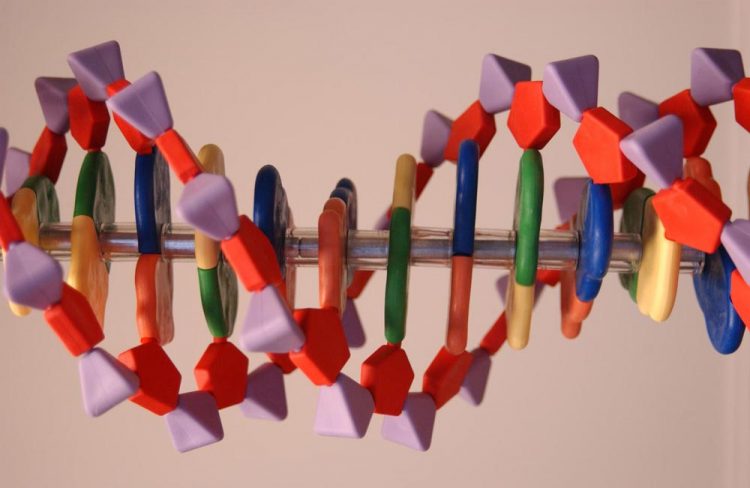Tailored DNA shifts electrons into the 'fast lane'

Each ribboning strand of DNA in our bodies is built from stacks of four molecular bases, shown here as blocks of yellow, green, blue and orange, whose sequence encodes detailed operating instructions for the cell. New research shows that tinkering with the order of these bases can also be used to tune the electrical conductivity of nanowires made from DNA. Credit: Maggie Bartlett, NHGRI
DNA molecules don't just code our genetic instructions. They can also conduct electricity and self-assemble into well-defined shapes, making them potential candidates for building low-cost nanoelectronic devices.
A team of researchers from Duke University and Arizona State University has shown how specific DNA sequences can turn these spiral-shaped molecules into electron “highways,” allowing electricity to more easily flow through the strand.
The results may provide a framework for engineering more stable, efficient and tunable DNA nanoscale devices, and for understanding how DNA conductivity might be used to identify gene damage. The study appears online June 20 in Nature Chemistry.
Scientists have long disagreed over exactly how electrons travel along strands of DNA, says David N. Beratan, professor of chemistry at Duke University and leader of the Duke team. Over longer distances, they believe electrons travel along DNA strands like particles, “hopping” from one molecular base or “unit” to the next. Over shorter distances, the electrons use their wave character, being shared or “smeared out” over multiple bases at once.
But recent experiments lead by Nongjian Tao, professor of electrical engineering at Arizona State University and co-author on the study, provided hints that this wave-like behavior could be extended to longer distances.
This result was intriguing, says Duke graduate student and study lead author Chaoren Liu, because electrons that travel in waves are essentially entering the “fast lane,” moving with more efficiency than those that hop.
“In our studies, we first wanted to confirm that this wave-like behavior actually existed over these lengths,” Liu said. “And second, we wanted to understand the mechanism so that we could make this wave-like behavior stronger or extend it to even longer distances.”
DNA strands are built like chains, with each link comprising one of four molecular bases whose sequence codes the genetic instructions for our cells. Using computer simulations, Beratan's team found that manipulating these same sequences could tune the degree of electron sharing between bases, leading to wave-like behavior over longer or shorter distances. In particular, they found that alternating blocks of five guanine (G) bases on opposite DNA strands created the best construct for long-range wave-like electronic motions.
The team theorizes that creating these blocks of G bases causes them to all “lock” together so the wave-like behavior of the electrons is less likely to be disrupted by random wiggling in the DNA strand.
“We can think of the bases being effectively linked together so they all move as one,” Liu said. “This helps the electron be shared within the blocks.”
The Tao group confirmed these theoretical predictions using break junction experiments, tethering short DNA strands built from alternating blocks of three to eight guanine bases between two gold electrodes and measuring the amount of electrical charge flowing through the molecules.
The results shed light on a long-standing controversy over the exact nature of the electron transport in DNA, Beratan says. They might also provide insight into the design of tunable DNA nanoelectronics, and into the role of DNA electron transport in biological systems.
“This theoretical framework shows us that the exact sequence of the DNA helps dictate whether electrons might travel like particles, and when they might travel like waves,” Beratan said. “You could say we are engineering the wave-like personality of the electron.”
###
Other authors include Yuqi Zhang and Peng Zhang of Duke University and Limin Xiang and Yueqi Li of Arizona State University.
This research was supported by grants from the Office of Naval Research (N00014-11-1-0729) and the National Science Foundation (DMR-1413257).
CITATION: “Engineering nanometer-scale coherence in soft matter,” Chaoren Liu, Yuqi Zhang, Peng Zhang, David N. Beratan, Limin Xiang, Yueqi Li, Nongjian Tao. Nature Chemistry, June 20, 2016. DOI: 10.1038/nchem.2545
Media Contact
All latest news from the category: Life Sciences and Chemistry
Articles and reports from the Life Sciences and chemistry area deal with applied and basic research into modern biology, chemistry and human medicine.
Valuable information can be found on a range of life sciences fields including bacteriology, biochemistry, bionics, bioinformatics, biophysics, biotechnology, genetics, geobotany, human biology, marine biology, microbiology, molecular biology, cellular biology, zoology, bioinorganic chemistry, microchemistry and environmental chemistry.
Newest articles

First-of-its-kind study uses remote sensing to monitor plastic debris in rivers and lakes
Remote sensing creates a cost-effective solution to monitoring plastic pollution. A first-of-its-kind study from researchers at the University of Minnesota Twin Cities shows how remote sensing can help monitor and…

Laser-based artificial neuron mimics nerve cell functions at lightning speed
With a processing speed a billion times faster than nature, chip-based laser neuron could help advance AI tasks such as pattern recognition and sequence prediction. Researchers have developed a laser-based…

Optimising the processing of plastic waste
Just one look in the yellow bin reveals a colourful jumble of different types of plastic. However, the purer and more uniform plastic waste is, the easier it is to…



